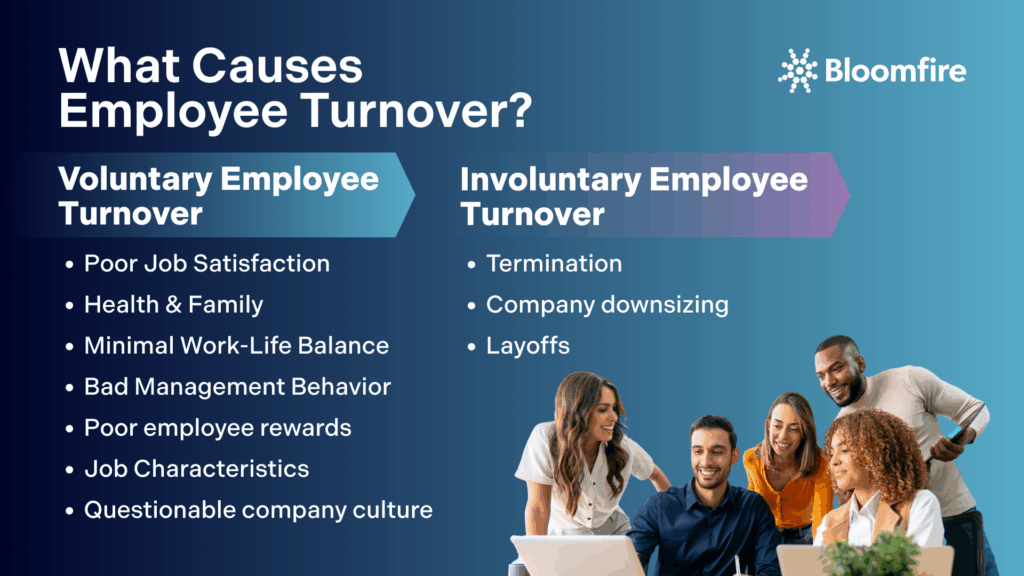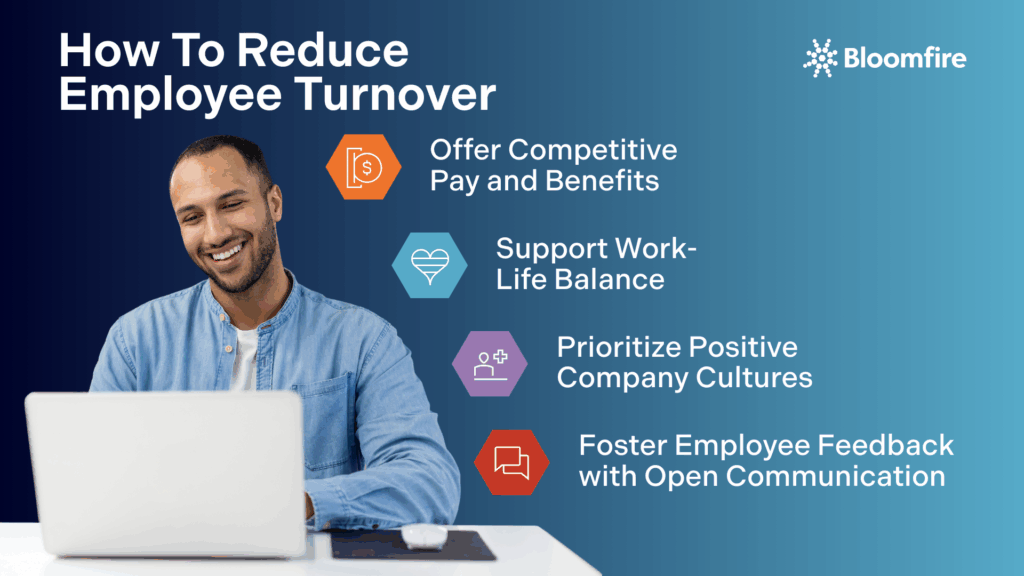The Real Cost of Replacing an Employee

Employee turnover is more than just a staffing challenge. The real cost of replacing an employee goes beyond the numbers.
When losing employees, the impact is felt far beyond the hiring budget. Recruiting, interviewing, and onboarding all come with significant expenses. However, the hidden cost of replacing an employee, like lost productivity, decreased morale, and the departure of valuable institutional knowledge, can weigh even heavier on an organization.
For companies aiming to grow and thrive, understanding the effects of employee turnover is essential. This involves assessing how turnover disrupts teams, slows progress, and even damages company culture. Understanding the true costs of employee turnover is important for organizations seeking to protect their bottom line, maintain productivity, and foster long-term employee engagement.
What is Employee Turnover?
Employee turnover refers to the rate at which employees leave an organization and must be replaced by new hires. It is one of the most closely monitored workforce metrics because it reflects not only the stability of a company’s staff but also the health of its culture, leadership, and overall operations.
High turnover can signal deeper organizational issues, while low turnover often points to strong employee engagement, effective management, and competitive compensation. There are two types of employee turnover that companies consider when calculating their turnover rate:
– Voluntary: Voluntary turnover occurs when employees leave the company by their own accord.
– Involuntary: Involuntary turnover occurs when employees are let go by their employers.
When analyzing turnover, many companies focus primarily on voluntary departures, as they can provide valuable insight into how employees truly feel about their workplace experience. However, the most accurate picture of workforce health comes from examining both voluntary and involuntary turnover together, and looking at the reasons behind each. This combined perspective allows leaders to identify and address problem areas before turnover becomes too costly or disruptive.
How Do You Calculate Employee Turnover?
To calculate the cost of employee turnover, divide the number of employees who left during a specific time period (such as a calendar year) by the total number of your company’s employees, then express the result as a percentage. For example, if your company of 700 employees lost 35 people, the employee turnover rate would be 5%.
For a more accurate understanding of employee turnover in your company, calculate the voluntary and involuntary turnover rates separately. For example, if your voluntary turnover rate is much higher than your involuntary turnover rate, that could signal issues like poor job satisfaction, uncompetitive pay, or lack of company advancement. By calculating these turnover rates separately, you can better understand the underlying causes of turnover in your company. If the voluntary turnover rate is higher than expected, you might need to understand why your employees are voluntarily moving on from your company.
What Causes Employee Turnover?
Employee turnover can be caused by different factors, depending on whether the turnover was voluntary or involuntary. It can be helpful to look at patterns of turnover to see if there are any cracks in your company.

To reiterate, voluntary turnover occurs when employees decide to leave the company on their own. In a study done in 2024, the main causes of voluntary employee turnover are as follows:
- Career development (18.9%): Lack of growth opportunities and insufficient professional development in the company is the leading cause of losing employees in your company.
- Health and family (12.4%): Personal health, family dynamic, or caregiving issues can arise. If companies aren’t supporting their employees’ health or families, they will be more inclined to leave the company
- Work-Life Balance (11.9%): Employees prefer a healthy balance between their professional and personal lives. If companies don’t offer flexible scheduling or opportunities for remote work while increasing their teams’ workload, your company might be losing employees.
- Management Behavior (9.7%): If there are poor leadership teams that lack communication and don’t support their employees, team members will inevitably find another company that has better care for their employees.
- Poor employee rewards (8.2%): Employees may feel dissatisfied with their pay or benefits when they believe these do not meet market standards. This dissatisfaction can stem from an actual unfairness in how their compensation compares to others in similar roles. Such feelings of inequity can impact overall job satisfaction and retention.
- Job characteristics (8.0%): The nature of a role can affect employee satisfaction, especially when there is a poor fit between the job and the individual’s skills or interests. Additionally, a lack of meaningful work or the physical and emotional demands of the position can lead to dissatisfaction and burnout.
- Company values (7.0%): Employees may choose to leave an organization because of concerns related to its culture, facilities, or physical environment. Issues with the company’s mission and values, safety, diversity, or relationships with coworkers can also contribute to losing employees.
Involuntary turnover is based on a company’s decision to let an employee go, which can be for many reasons. According to the same study, only 6.6% of employee turnover comes from involuntary turnover, which can be caused by the following:
- Termination: An employer can end someone’s employment for reasons other than the worker’s choice. This can include performance-related dismissals, misconduct, or other employer-driven decisions, often leaving employees unprepared and dissatisfied.
- Company downsizing: Downsizing involves permanently reducing the number of employees to improve efficiency or cut costs. It often results in job losses and can impact employee morale across the organization, even among those who remain.
- Layoffs: Layoffs occur when an organization temporarily reduces its workforce due to financial pressures, restructuring, or changes in business needs. These decisions are typically beyond the employees’ control and can create uncertainty and stress for those affected.
While employee turnover can take place for many reasons, the result often stays the same: teams fall behind, employees become less motivated, and employers waste quality time searching for a new employee. By learning why employees are leaving the company, you can prevent any future employees from quitting.
What is The Cost to Replace an Employee?
When an employee leaves the company, it can be incredibly costly to hire a new employee, not just financially. The cost of replacing employees can look different depending on the role of the employee and their length of employment with the company. Research at Murray State University explains that the average cost of replacing an employee can be nearly 150% of that employee’s salary, and can increase with higher positions. The cost of replacing employees goes beyond the financial cost, as there are indirect and knowledge costs with losing employees. So how much does it cost to replace an employee?
The Indirect Costs of Employee Turnover
The cost of replacing an employee goes beyond the employee who’s quitting, as there are indirect costs that can negatively affect your company. By understanding the indirect costs of employee turnover, companies can have a greater understanding of the cost of employee turnover. Below are the largest indirect costs of replacing an employee:
Loss of Productivity
When an employee leaves, it can take months for the company to hire someone new. Then, it can take months or even years for that employee to reach the same productivity level. During that period, remaining team members can face heavier workloads, bottlenecks, or unfinished projects while the company adjusts, leading to even less productivity.
Decreased Morale
Losing an employee doesn’t only affect productivity, but it also hurts workplace culture. When employees see colleagues frequently leaving, they may start questioning the stability of the company or their own future. This uncertainty can result in stress, disengagement, and even resentment toward management. Over time, diminished morale can weaken team cohesion, decrease motivation, and further encourage employees to seek opportunities elsewhere.
Leadership and Management Distractions
When employees leave, leadership and management teams need to look for a new person to fill the empty position. This can take tons of time, shifting their focus from important company tasks to hiring a new employee. This shift in their focus can impact the teams working for them, as they won’t be as attentive and productive on current projects.
Reputational Damage
If employee turnover is common or handled poorly, your company’s reputation could face some heavy costs. Parting employees might leave reviews on their experience, which can be negative if their reason for leaving is negative. If it’s public knowledge that your company has a high turnover rate, you might have trouble attracting and retaining new team members.
Companies can potentially suffer long-term costs if employee turnover is high and not handled properly. The indirect costs of employee turnover can heavily outweigh any financial costs of replacing an employee. Therefore, it’s important that any indirect costs of replacing an employee are minimized or eliminated from your company.
Financial Cost of Replacing an Employee
The financial cost of replacing an employee can vary based on company size and the previous employee’s job title and experience. If a new employee takes a long time to become as efficient and productive as the previous one, the financial costs of onboarding and productivity can increase. For example, a call-center company with a 30% turnover rate will have to pay nearly $350,000 in recruitment and onboarding costs. That’s valuable company profit that could be used elsewhere, which can be prevented with practical ways to reduce employee turnover.
To better understand the financial costs of replacing an employee, it’s important to consider the onboarding costs (the time to pay someone to learn) with the actual work they provide for the company. The Value of Enterprise Intelligence report discusses the costs associated with onboarding and employee turnover and how Bloomfire’s knowledge management platform can help lower these costs. Bloomfire’s is able to save companies nearly $800,000 in onboarding costs by speeding up the time for new employees to complete training. These costs can be much greater, depending on your company’s size. Implementing a knowledge management system allows your company to reduce costs and redirect resources toward driving the organization forward.
Cost of Knowledge Loss of Employee Turnover
Losing knowledge from employee turnover can have long-term effects on your company. If knowledge isn’t properly documented, long-term employees may leave with years of valuable, irreplaceable experience. If your company has a high turnover rate or undergoes layoffs, you’ll experience difficult knowledge management challenges. This dwindling pool of knowledge can harm your company in various ways:
- Loss of expertise: The challenge isn’t merely about how many employees leave, but rather the depth of knowledge they take with them. Long-term employees can leave the company with so much vital experience that it can take anywhere from weeks to months to fully replicate for a new employee. If knowledge isn’t stored properly, this process can take even longer.
- Onboarding hurdles: The departure of seasoned professionals leaves organizations facing the complex task of bringing new hires up to speed. Without the guidance of subject matter experts and adequate documentation, the ramp-up time for new employees can be significantly longer, making integration and productivity more challenging.
- Information silos: Knowledge gaps start to arise when long-term employees with valuable knowledge leave the company. If processes were never documented, then knowledge can be lost with the new employee. This is an information silo problem, where knowledge is isolated to specific team members. Information silos can negatively impact productivity and efficiency in your company.
Knowledge loss can be a long-term pain point for your company, so it’s important to prevent any knowledge from being siloed or lost during employee turnover. By implementing a knowledge management program, employee knowledge can be easily captured and stored in an easy-to-access system. So when an employee leaves the company, their knowledge won’t be lost.
How Can You Reduce Employee Turnover?
Reducing employee turnover is important for the strength of your company, along with the well-being of your employees. Companies should address employee turnover by focusing on strategies that promote workplace culture and employee needs.

Offer Competitive Pay and Benefits
Employees often leave a company for a role that pays better or offers more attractive employee benefits. Offering competitive pay and benefits is key to retaining your employees. Consider offering healthcare to reduce financial stress and retirement plans to encourage employee retention. You can also communicate to employees about what benefits they would like to have so they can feel heard and welcomed. It is also beneficial to be transparent about salary ranges to improve your employees’ satisfaction and trust with management.
Support Work-Life Balance
Offering flexible work opportunities like remote or hybrid work can encourage employee retention. If your company is unable to provide remote work, provide compressed and manageable workweeks with flexible hours. Employees care about their work-life balance, so providing adequate paid time off and wellness programs will increase your team’s engagement and productivity as they won’t feel burned out too quickly.
Prioritize Positive Company Culture
Employees who fit well within their workplace culture have greater job satisfaction and are much less likely to leave the organization. Positive workplace culture consists of treating others with respect, building inclusion, and offering rewards for employees who exceed expectations. Further, build employee trust, lead by example, promote collaboration, and emphasize personal well-being so team members feel valued in your company.
Foster Employee Feedback with Open Communication
Open communication is not strictly about voicing problems, it’s also about voicing success and employee strengths. Encourage employees to give feedback without any fear or consequences. Leadership teams should also openly applaud the success of their employees when it is warranted, so everyone will be motivated to work harder and stay at the company. Opening this communication will help your employees build a greater trust with other co-workers and promote their personal growth within the company.
By implementing these strategies, employees will want to stay with your company long-term. But when employee turnover does occur, it’s important to keep their expertise with the company so knowledge isn’t lost with them. By implementing a knowledge management platform like Bloomfire, knowledge can be easily stored and never siloed away. By storing company-wide knowledge and reducing employee turnover, your company can succeed and innovate better than before.
Frequently Asked Questions
What is considered a good turnover rate?
A healthy turnover rate is typically around 10%, but this value can vary depending on the job type and the company size. This value implies that employees are generally happy in your company and are staying long enough to be productive and contribute meaningfully.
What are the risks of ignoring involuntary turnover data?
Focusing solely on voluntary turnover can hide deeper company problems, such as poor hiring practices, ineffective management, or financial constraints that can lead to layoffs. Ignoring involuntary data reduces the ability to diagnose workforce challenges comprehensively, so it’s important to focus on all employee turnover within your organization.
How long does it typically take for a new employee to reach full productivity?
The time for new employees to reach full productivity varies by their role and company, but often ranges from several months to over a year. This can be even longer for specialized or senior positions. Effective onboarding and implementing a knowledge management platform can significantly shorten this period.
Securing Long-Term Success Through Employee Retention
Over time, your employees accumulate a vast amount of knowledge, experience, and industry expertise. As a result, losing those employees can be costly, not only to your company’s success but to the quality of your customer service.
The cost of replacing an employee goes beyond expertise, as current employees can lose morale and fear their job security with large turnover rates. To prevent employee turnover, it’s important to give your employees a reason they want to work for your company. Employee retention costs are substantially less than employee turnover costs, so implementing employee retention strategies in your company will result in your employees feeling satisfied at their jobs and more engaged in the work they do, which will boost your company’s success.
rm success.
This blog post was originally published in December 2017. It was expanded and updated in August 2025.


Enterprise AI Search: Definition, Benefits, and Evolution

The Benefit of Company-Wide Knowledge Management in 2026

Are You Making These Common Knowledge Sharing Mistakes?

Estimate the Value of Your Knowledge Assets
Use this calculator to see how enterprise intelligence can impact your bottom line. Choose areas of focus, and see tailored calculations that will give you a tangible ROI.

Take a self guided Tour
See Bloomfire in action across several potential configurations. Imagine the potential of your team when they stop searching and start finding critical knowledge.